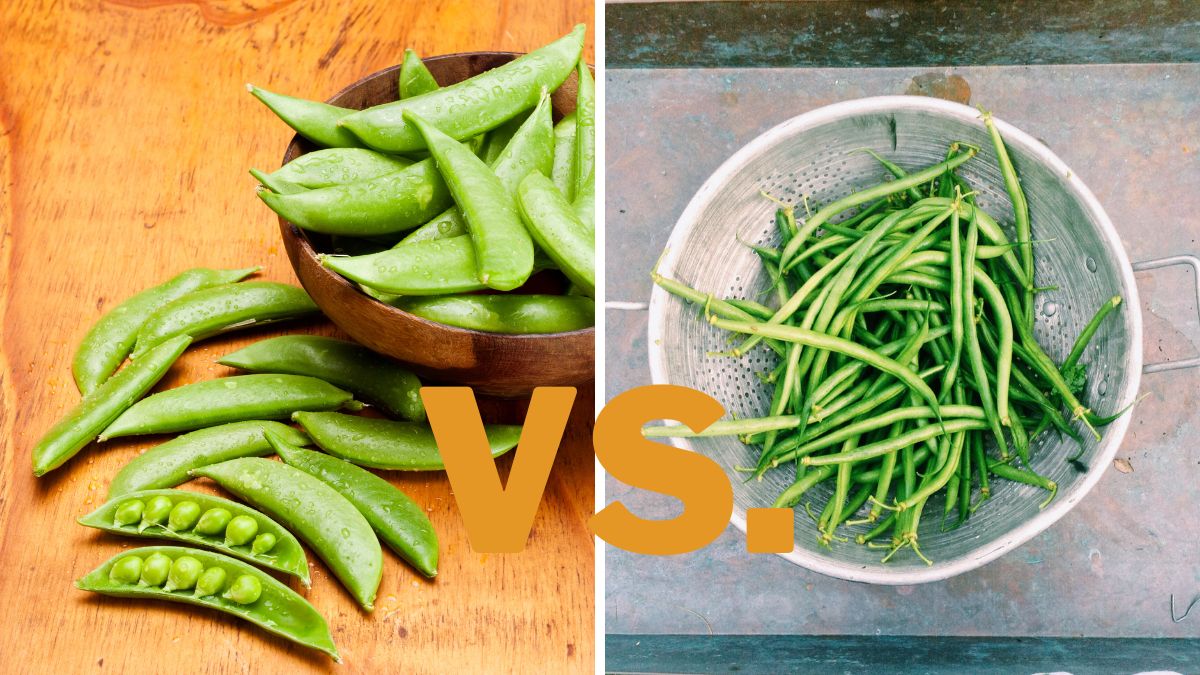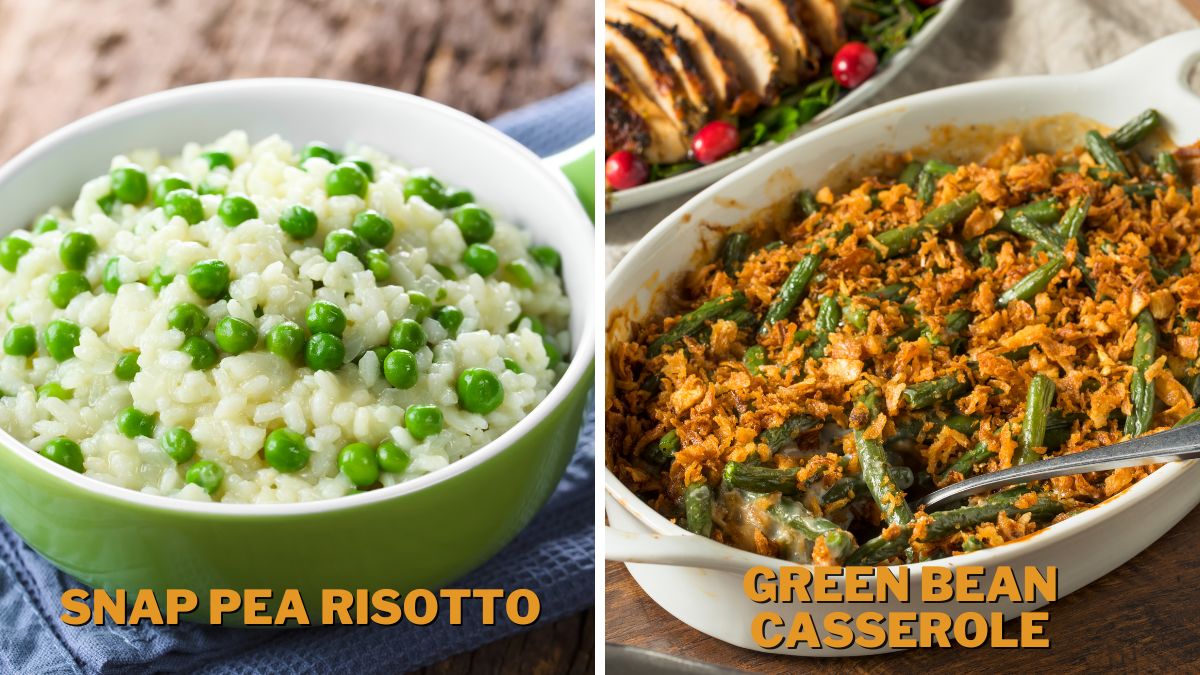Snap Peas vs. Green Beans: Differences

A few days ago, I went to the farmer’s market and I saw sugar snap peas and instantly went down memory lane when I was little and had them as a healthy snack. I frequently use snap peas as well as green beans in my cooking, so I decided to dedicate an article to this vegetable.
To spruce things up, I decided to make it a comparison article, comparing snap peas and green beans. Similar but fundamentally different, each of these veggies has its specificities. In this article, I will tell you everything you need to know about both, and hopefully help you choose the right one for your next meal.
Comparison Between Snap Peas and Green Beans
Having grown them both, snap peas and green beans are among my favorite veggies to cook with. Both delicious, versatile, and easy to cook and pair, they are frequently on my menu.
Growing
Snap peas and green beans require different styles of growing, which contributes to their differences. Luckily, I have some experience in this, so I can tell you how they are grown first hand.
Until a few years ago, snap peas and green beans were a part of my yard garden, so I have had the chance to gather substantial knowledge in this aspect.
Snap peas are cool-season crops, which came as a huge surprise for me since I thought that all crops need warm temperatures. They thrive in early spring, so that’s when you need to grow them.
To grow your snap peas in the early spring, you need to plant them in late winter. I planted them at the end of February in moderately cold winters, but some years, I planted them as late as mid-March.
It is crucial that you avoid extreme cold and hot temperatures when growing snap peas, as they won’t make it in such conditions. So, timing is crucial, and you must adhere to it.
I don’t know if you knew this, but snap peas are climbing plants and are very decorative as a bonus. They naturally produce tendrils that help them climb onto a supportive structure, so keep this in mind if you want to start growing them. This climbing feature makes them very enduring and strong since they are naturally protected from dirt and diseases caused and spread by insects.
To grow beautiful snap peas, you’ll need proper support structures. I had bamboo stakes stuck into my garden. Bamboo is very good for plant support since it has a smooth surface and it doesn’t rot easily.
My first batch of snap peas was less than successful because I didn’t know one crucial thing- watering. They require constant moisture and need to be watered daily. I watered them every two days because I really thought that they didn’t need any more water. However, my moisture standards and theirs were completely different.
Harvesting has always been the best part for me, not because I don’t enjoy growing snap peas, but because the harvest typically occurs in early summer. Harvest your snap peas about 60 to 70 days after planting.
Green beans on the other hand, are warm-season crops, and they are very sensitive to frost, so you should plant them in late spring or early when the weather is consistently warm.
I grew pole beans which grow as long vines and require support structures. Bamboo worked great for these too. There’s another kind of green beans that grow as bushes, but due to lack of space, I didn’t grow them.
Both types require well-drained soil and organic fertilizer. Don’t add artificial fertilizer because it may be too strong for them. Egg shells and banana peels are great fertilizers for garden crops.
Just like snap peas, green beans need constant moisture, so water them daily.
A fun fact about harvesting green beans is that the harvest triggers more green beans generation, so the more you pick them the more they grow. You should harvest them about 60 days after planting.
Appearance And Size
Snap peas and green beans are very similar in appearance and size, but they do have distinctive looks.
Split peas have rounded pods with a slightly curved shape. The peas are visible through the pod, and they have a bright green color when they are mature.
The green bean pods are elongated and have a straighter shape than the snap peas pods. Green beans have a lighter green shade, but can find them in yellow as well as in purple color.
Taste
Both snap peas and green beans are delicious. While you can snack on snap peas directly from the pod, raw and uncooked green beans require cooking. Snap peas are delicious when cooked as well.
Snap peas are delightfully sweet and crisp with an underlying earthy tone and refreshing notes. I particularly love their texture that snaps with fresh juices when you bite them.
Green beans have a milder flavor than snap peas, which is why I recommend cooking them because they feel a bit tasteless and bland when raw. However, you may like their slight nuttiness refreshing if you have them uncooked.
Cooking Time And Methods
Both snap peas and green beans require nothing more than light cooking, so you won’t need a lot of energy or time to turn them into a delicious meal. You can cook them in multiple ways, so boiling, roasting, or sautéing are all great options.
You can cook them as they are or combine them with different vegetables or sauces. I prefer them with other veggies, especially when combined with onions and peppers, but I also enjoy them plain.
They are both very tender when cooked, with green beans being a little crispier. When cooked, snap peas are very soft, and you can easily turn them into cream.
Popular Uses
Green beans and snap peas are among the most commonly used veggies worldwide. They grow almost everywhere, and even if they can’t be naturally found in some parts of the world, they are available to buy.
They are extremely versatile and fit into many diet styles. You can add them to salads or make delicious cooked meals with them. They go great with roasts or vegetarian dishes. They fit amazingly with pasta sauces, especially green beans, due to their creamy consistency when cooked.
Both snap peas and green beans have unique features and flavors, making them excellent choices depending on personal preference and culinary use. I find them both delicious, and often pair them together when I can’t decide which I want to have in my meal.
The most popular meals with snap peas include vegetable soup, snap pea puree, risotto and roasted sugar snap peas. Green beans, on the other hand, are the most popular during holiday season since we often make them in form of the casserole for Thanksgiving and Christmas.

Popularity
Snap peas and green beans are especially popular in Asian cuisine, but that doesn’t mean that they aren’t popular in the rest of the world. They are very common in Europe, too, as well as in the US.
Green beans are especially popular in Western European and American cuisine as a common side dish to many dinner plates.
Snap peas are a regular component of many European dishes, as well as the famous holiday mashed potatoes.
To sum things up, I made a table that will help you choose the right peas for your next meal.
| Feature | Snap Peas | Green Beans |
|---|---|---|
| Growing | Cool-weather crops, need support, and constant moisture | War-weather crops, some don’t need support but some do, they need constant moisture and natural fertilizer |
| Appearance | Plump with visible peas | Slimmer with more uniform pods |
| Taste | Sweet, earthy, fresh and crunchy | Milder, earthy, and nutty |
| Cooking | Boil, roast, sauté, stir-fry | |
| Uses | Very versatile. They make excellent side dishes and snacks. | |
| Popularity | Available worldwide and popular in Asian, European, and American cuisine | |
| Nutrition | Rich in vitamins, fiber, and minerals. | |
